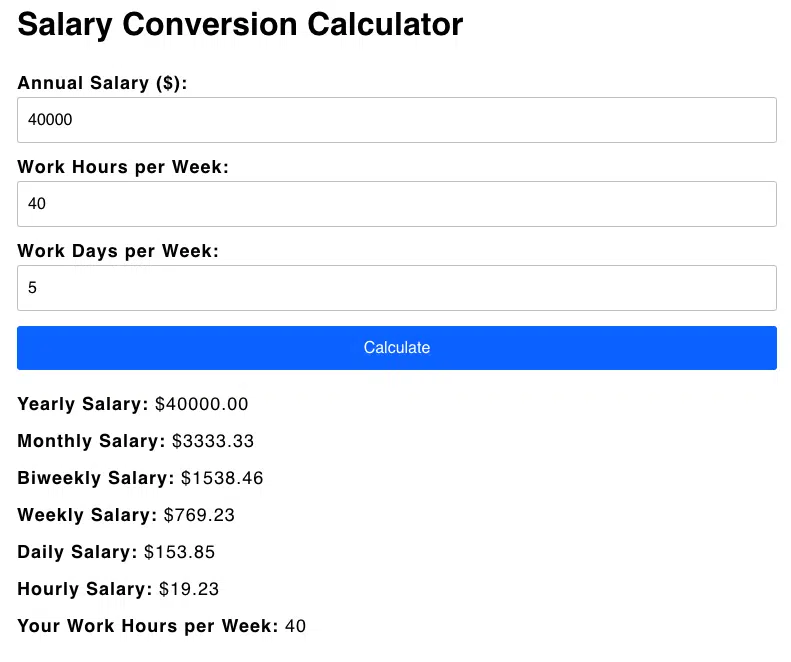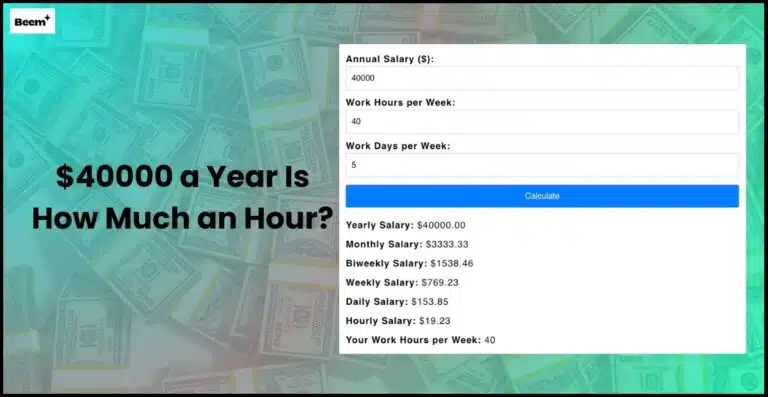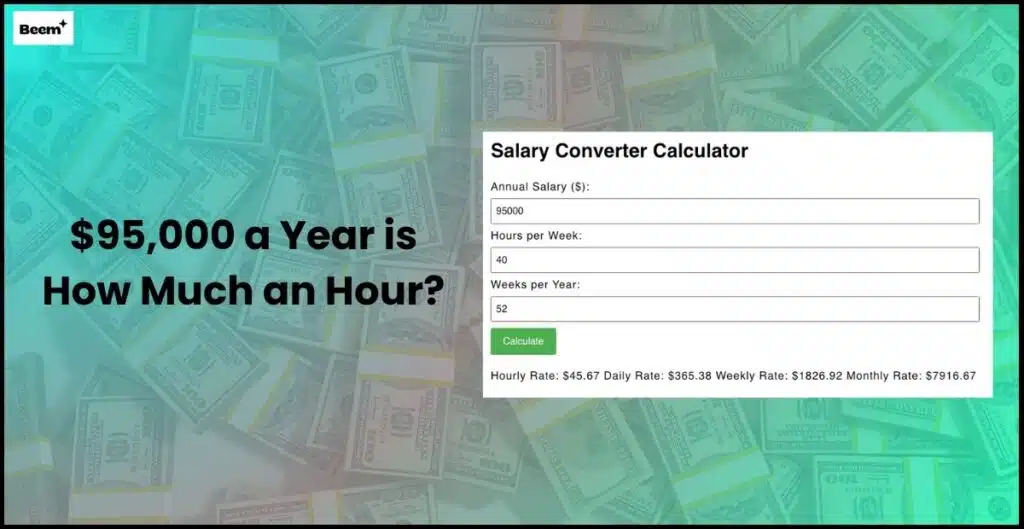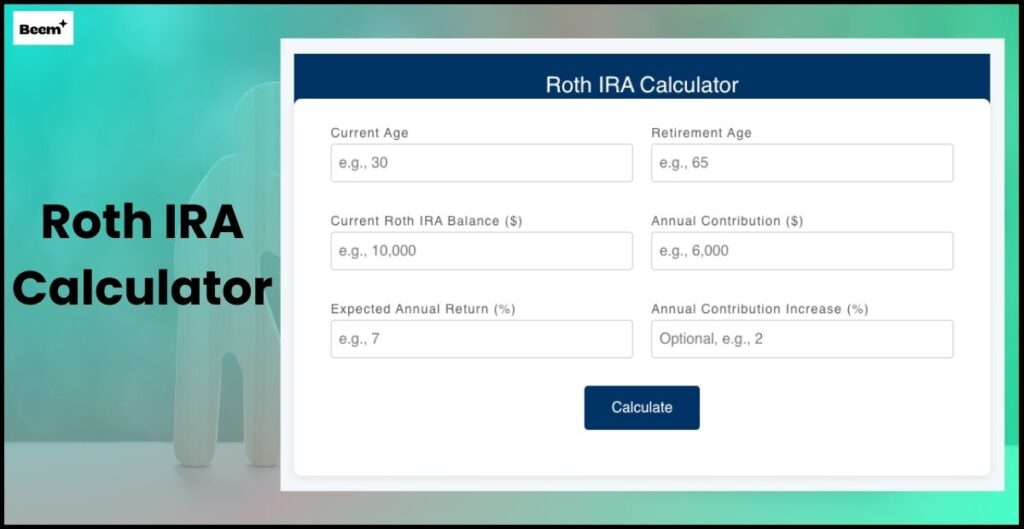When budgeting your finances or comparing job offers, understanding the relationship between an annual salary and an hourly wage is crucial. Many ask, “40 000 a year is how much an hour?”
In this guide, we’ll break down the process of converting a $40,000 salary to hourly rates, look at the assumptions behind these calculations, and discuss important factors that might affect your take-home pay.
Whether you’re new to budgeting or rethinking your career options, this article will serve as a detailed resource on how to determine the hourly rate for a $40,000 annual salary.
Salary Conversion Calculator
Understanding the Basics of Salary Conversion
When you earn an annual salary, that figure is usually based on a standard full-time work schedule. For most full-time positions in the United States, the typical expectation is around 2,080 working hours per year. This is calculated by multiplying 40 hours per week by 52 weeks in a year:
- 40 hours/week × 52 weeks/year = 2,080 hours/year
Thus, if you have an annual salary of $40,000, dividing this number by 2,080 gives you the approximate hourly wage. This fundamental calculation is the basis of converting an annual salary to an hourly wage.
However, it’s important to note that some jobs may have different work hours or include overtime, unpaid breaks, or other factors. When searching “40000 a year is how much an hour,” you’re generally considering the average, but real-life variations may occur.
Calculating the Hourly Wage: Step-by-Step Guide

Let’s break down the process of calculating the hourly wage from an annual salary:
Step 1: Determine the Total Annual Hours
As mentioned, the standard full-time work schedule is typically 2,080 hours per year.
Step 2: Divide the Annual Salary by Total Annual Hours
For a $40,000 annual salary, the calculation would be:

Thus, 40k a year is how much an hour? It works out to be approximately $19.23 per hour.
Step 3: Adjust for Variations in Hours
If your job requires more or fewer hours, or if you work part-time, you might need to adjust the calculation. For example, if you work 35 hours a week instead of 40, your total annual hours would be:

Then, the hourly rate for a $40,000 salary becomes:

This example demonstrates that the hourly wage can vary depending on the total number of hours worked.
Step 4: Consider Benefits and Overtime
Keep in mind that the hourly wage calculated from your annual salary might not fully reflect your take-home pay if you have additional benefits, overtime pay, or deductions.
Some roles include paid time off, healthcare benefits, and bonuses that factor into your overall compensation package.
Factors Impacting the Calculation
While the simple math provides a clear number, several factors can influence how accurately this calculation represents your actual earnings:
1. Paid Time Off and Holidays
Many salaried positions come with paid vacations and holidays. If you’re paid for days you’re not working, this may affect your effective hourly wage. For example, if you’re paid for 10 holidays and 15 vacation days, you might be working fewer than 2,080 hours even though your salary is based on that number.
2. Overtime and Extra Hours
Some jobs offer overtime pay, which can increase your overall earnings. When calculating “40000 salary to hourly” rates, make sure you’re only using the standard hours if your salary is strictly based on a 40-hour work week.
3. Part-Time vs. Full-Time Employment
If you’re working part-time, the conversion formula changes because your annual hours will be less. The formula remains the same, but the denominator (total hours worked) is smaller, thereby increasing your hourly rate if your annual income remains constant.
4. Geographical Variations
Cost of living differences between locations can also impact your interpretation of what $40,000 per year means in terms of hourly pay. For instance, $40,000 in a metropolitan area with a high cost of living may provide a different quality of life than in a more rural area.
5. Taxes and Deductions
The calculation of $19.23 per hour is a gross figure. Once taxes, healthcare premiums, and other deductions are taken into account, your net hourly wage will be lower.
Practical Examples and Scenarios
To further illustrate how to convert an annual salary to an hourly wage, let’s look at several practical scenarios.
Scenario 1: Full-Time Employment with Standard Hours
For a full-time employee working 40 hours per week, the calculation is straightforward:
- Annual Salary: $40,000
- Total Annual Hours: 2,080
- Hourly Wage: $40,000 ÷ 2,080 ≈ $19.23 per hour
This scenario is the most common and is what people refer to when they ask, “40 000 a year is how much an hour?“
Scenario 2: Full-Time Employee with Paid Time Off
Imagine an employee whose contract includes 15 vacation days and 10 paid holidays. If these days are factored into their salary, the number of hours actively worked might be less than 2,080. However, for salary conversion purposes, employers typically still use 2,080 as the denominator because the paid time off is already included in the annual salary.
Scenario 3: Part-Time Work
Consider a part-time worker who earns $40,000 a year but works 30 hours per week. The total annual hours for this worker would be:

Then, the hourly rate is:

Here, even though the annual salary is the same, the hourly rate is significantly higher due to the reduced number of working hours.
Scenario 4: Freelance and Contract Work
For freelancers or contractors who might not work a consistent number of hours every week, converting an annual salary to an hourly wage requires tracking billable hours more precisely. In these cases, professionals often set an hourly rate higher than the simple division might suggest to account for the time spent on non-billable activities such as marketing, administration, or client acquisition.
Comparison with Other Salary Ranges

Understanding how $40,000 per year breaks down into an hourly wage is also helpful when comparing it to other salary ranges.
Lower-Paid Positions
For entry-level positions or roles in regions with lower living costs, $40,000 per year might be common. Converting this to an hourly rate, we get approximately $19.23 per hour.
When compared with jobs paying $30,000 a year, which would equate to about $14.42 per hour (assuming 2,080 hours), it’s clear how each figure represents different market rates.
Higher-Paid Positions
For professionals in more advanced roles or in high-demand industries like technology or finance, annual salaries might range from $60,000 to $100,000 or more. In these cases, the hourly conversion might yield:
$60,000 a year:

$100,000 a year:

Thus, when someone searches for 40000 a year is how much an hour or 40k a year is how much an hour, it can be informative to compare this with higher or lower salary ranges to assess value in the context of job opportunities and lifestyle expectations.
The Role of Benefits and Bonuses
Keep in mind that salary isn’t the only form of compensation. Many positions offer bonuses, stock options, health benefits, and retirement contributions. While these might not directly affect the hourly calculation, they are crucial components of overall compensation and should be considered when comparing job offers.
Budgeting with an Hourly Wage in Mind
Understanding your hourly wage is not just an academic exercise—it has practical implications for budgeting and financial planning. Here are some steps to help you manage your money more effectively:
1. Track Your Hours
If you’re a salaried employee, knowing your hourly rate can help you understand the value of each hour worked. For freelancers or part-time workers, it’s even more critical to track billable versus non-billable hours.
2. Calculate Overtime and Extra Income
In roles where overtime is an option, knowing your base hourly rate helps you calculate the extra income you might earn from overtime. For example, if overtime is paid at time-and-a-half, then for a base rate of $19.23 per hour, overtime pay would be approximately $28.85 per hour.
3. Plan for Taxes and Deductions
Remember that the hourly rate calculated from an annual salary is a gross figure. You’ll need to budget for federal and state taxes, Social Security, Medicare, and other deductions. A clear understanding of your gross versus net pay will help in making informed budgeting decisions.
4. Evaluate Job Offers
When comparing job offers, having a clear sense of how an annual salary converts into hourly wages can be useful—especially if the number of hours or benefits differ significantly between roles. Asking “40000 salary to hourly” can help clarify what you’re truly earning on an hourly basis, ensuring that you compare positions fairly.
5. Set Financial Goals
Once you have a clear understanding of your hourly rate, you can set more precise financial goals. Whether you’re saving for a down payment on a home, planning for retirement, or budgeting for everyday expenses, knowing the true value of your time is essential.
Tips for Negotiating Salary and Hourly Rates
Negotiating your salary or hourly rate is a common part of career advancement. Here are some tips to help you negotiate effectively:
1. Do Your Research
Before entering negotiations, research typical salaries for your role in your geographical area. Tools such as salary calculators and market reports can help you understand if $40,000 a year is competitive in your industry.
2. Highlight Your Experience
If you have extensive experience—especially in specialized fields like Fintech—make sure to highlight your expertise. Your background and the unique skills you bring to the table can justify a higher hourly rate.
3. Discuss Benefits as Part of the Package
Sometimes, employers might be reluctant to adjust base salary but may offer additional benefits. Consider the full compensation package—including bonuses, healthcare, retirement plans, and flexible hours—when negotiating.
4. Be Prepared to Explain Your Calculation
When asked, “40000 a year is how much an hour?”, being able to clearly explain the conversion process demonstrates your financial acumen and preparedness. Use your calculation as a baseline to negotiate further improvements.
5. Practice Your Pitch
Whether you’re negotiating for a new job or a raise, practice your pitch. Highlight your accomplishments, research data, and how your work adds value to the organization. Confidence and preparation can make a significant difference.
Conclusion
Understanding how to convert an annual salary to an hourly wage is a fundamental skill for budgeting, negotiating, and comparing job opportunities. By answering the question, “40000 a year is how much an hour?“—we’ve demonstrated that, using the standard 2,080 hours per year, a $40,000 salary equates to approximately $19.23 per hour.
Whether you’re evaluating your current job offer or comparing potential career moves, this calculation is essential. Keep in mind that factors such as paid time off, overtime, and regional cost differences may influence the final figure. Additionally, always consider the full compensation package when making career decisions.
In the realm of personal finance and career planning, being informed about your hourly rate from your annual salary can empower you to make smarter choices. With the insights provided in this guide, you now have a detailed understanding of the conversion process, the factors that affect it, and how to negotiate your worth.
Remember, if you’re ever in doubt or need personalized advice, consulting with a financial advisor or career coach might be beneficial. Armed with knowledge, you can confidently navigate the complexities of salary negotiations and financial planning.
Frequently Asked Questions About $40000 a Year Is How Much an Hour
How do I convert a $40,000 salary to an hourly wage?
To convert a $40,000 annual salary to an hourly wage, you divide the salary by the total number of working hours in a year. For a full-time job, this is typically 2,080 hours (40 hours per week multiplied by 52 weeks).
This simple division shows that 40k a year is how much an hour—approximately $19.23.
Why do some calculations for $40,000 a year give a different hourly rate?
Different calculations may yield different hourly rates because the total number of annual work hours can vary. While 2,080 hours is standard for full-time employment, part-time jobs or roles with extensive paid time off might have fewer hours, resulting in a higher hourly rate when the same annual salary is divided by a smaller number of hours.
Is it better to be paid hourly or receive an annual salary?
There is no one-size-fits-all answer. Hourly wages provide clarity on how much you earn per hour and can be beneficial if you work variable hours. An annual salary often includes benefits such as paid time off and may provide greater job security. Your preference might depend on your financial goals, work habits, and the specifics of the job.
Convert more salaries:
$42000 a Year Is How Much an Hour? | $95,000 a Year is How Much an Hour? | $40000 a Year Is How Much an Hour? | $60000 A Year Is How Much An Hour?
Explore More Calculators:
Auto Loan Calculator | Roth IRA Calculator | Retirement Calculator | 401(k) Calculator | Compound Interest Calculator





























